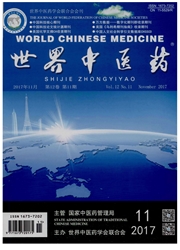

 中文摘要:
中文摘要:
目的:从中枢/外周观察针刺对急性强迫应激游泳模型大鼠海马/血清热休克蛋白70(HSP70)蛋白表达影响,探究针刺在急性应激下的抗损伤作用及是否涉及c-Jun氨基末端激酶(JNK)信号通路,揭示针刺相关急性抗抑郁机制。方法:将36只SD大鼠随机分成空白组、空白+JNK通路阻断剂(SP600125,以下简称SP)组、模型组、模型+SP组、针刺组、针刺+SP组,每组6只,采用强迫游泳应激结合孤养方法造模,针刺干预选取"百会""印堂"穴,每次20min,每天1次,治疗2d。采用酶联免疫吸附(ELISA)方法检测大鼠海马和血清的应激保护因子HSP70的蛋白表达水平。结果:与空白组比较,空白+SP组海马/血清热休克蛋白70表达水平无显著差异,模型组显著升高(P〈0.01)。与模型组比较,模型+SP组、针刺组、针刺+SP组海马/血清热休克蛋白70表达水平均显著降低(P〈0.01)。结论:针刺干预作用可作为保护因素减轻了急性应激对机体产生的不利影响,可能与抑制大鼠海马JNK信号通路活性有关。
 英文摘要:
英文摘要:
Objective: To explore the anti-injury effect of acupuncture in acute stress and whether c-Jun N-terminal Kinase(JNK) was involved based on effects of acupuncture on the expression of heat shock protein 70 in the hippocampus and serum of rat model of depression induced by force swimming stress in central and peripheral, to further investigate the molecular mechanism of acupuncture in the treatment of acute depression. Methods: Thirty-six Sprague-Dawley rats were randomly divided into 6 groups: control group, control+JNK inhibitor group(SP600125, SP for shot below), model group, model+SP group, acupuncture group and acupuncture+SP group, six rats each group. The rat model of depression was induced by the forced swimming combined with solitary raising method. Acupuncture groups were given acupuncture on acupoints of Baihui(GV 20) and Yintang(GV 29) for 20 min, once a day for 2 days. The contents of HSP70 in rat hippocampus and serum were detected by ELISA. Results: Compared with the control group, no obvious difference in the content of HSP70 in hippocampus and serum was found in control+SP group, but the contents of HSP70 were increased significantly in the model group(P〈0.01). Compared with the model group, the contents of HSP70 in hippocampus and serum in model+SP group, acupuncture group and acupuncture+SP group were significantly decreased(P〈0.01). Conclusion: Acupuncture intervention may protect the body from acute stress, the mechanism of which may be related to inhibit the activity of the JNK signal pathway in the hippocampus of rat model of depression induced by forced swimming stress.
 同期刊论文项目
同期刊论文项目
 同项目期刊论文
同项目期刊论文
 期刊信息
期刊信息
